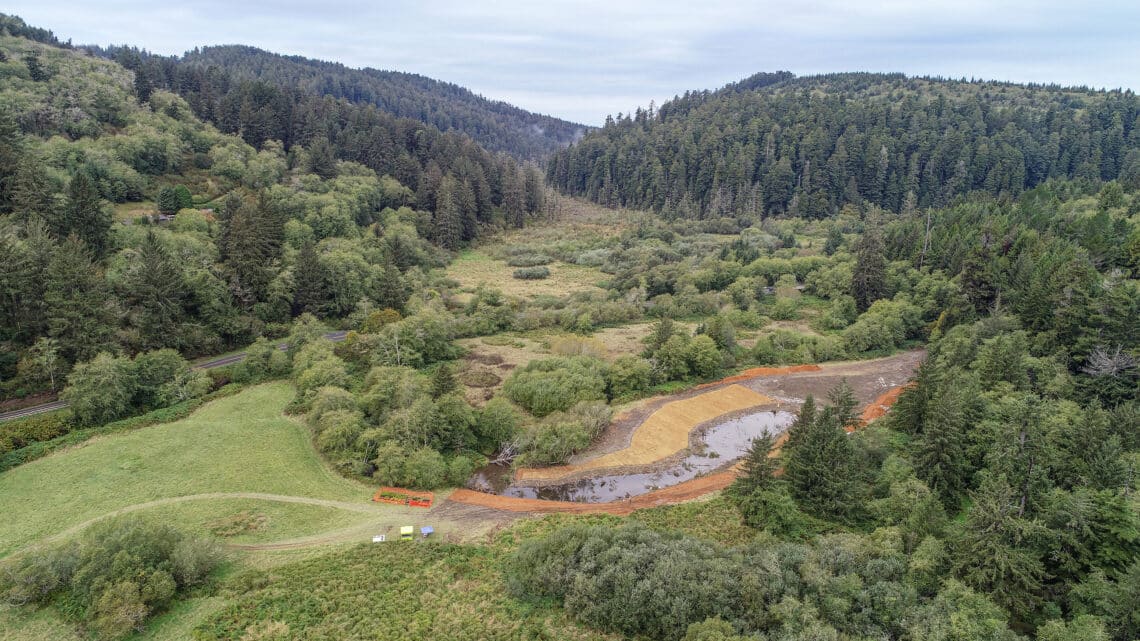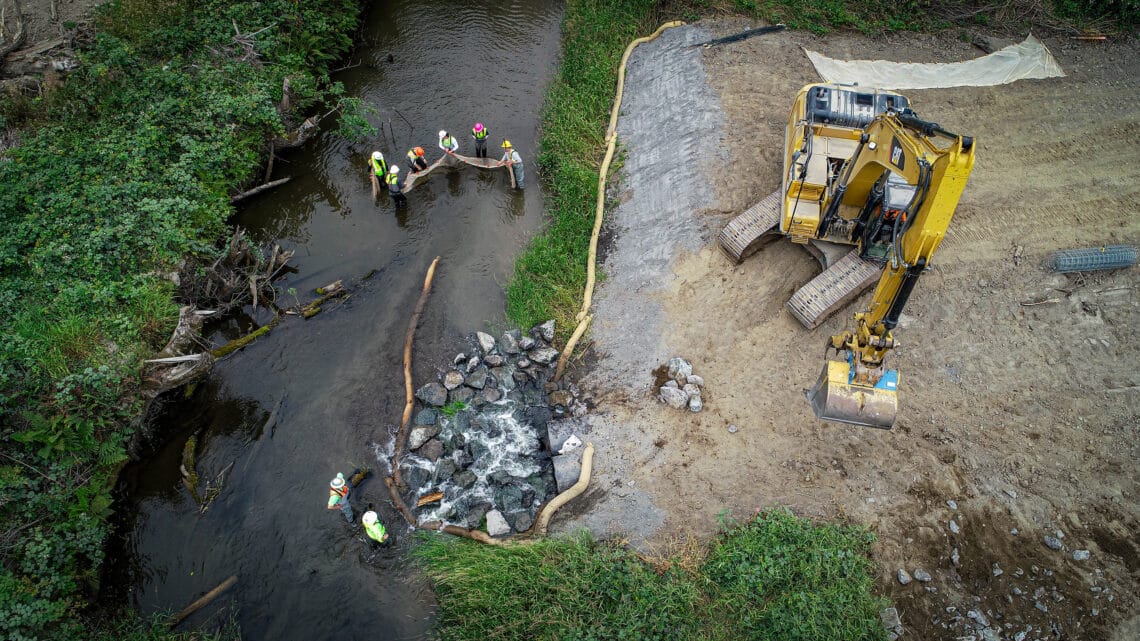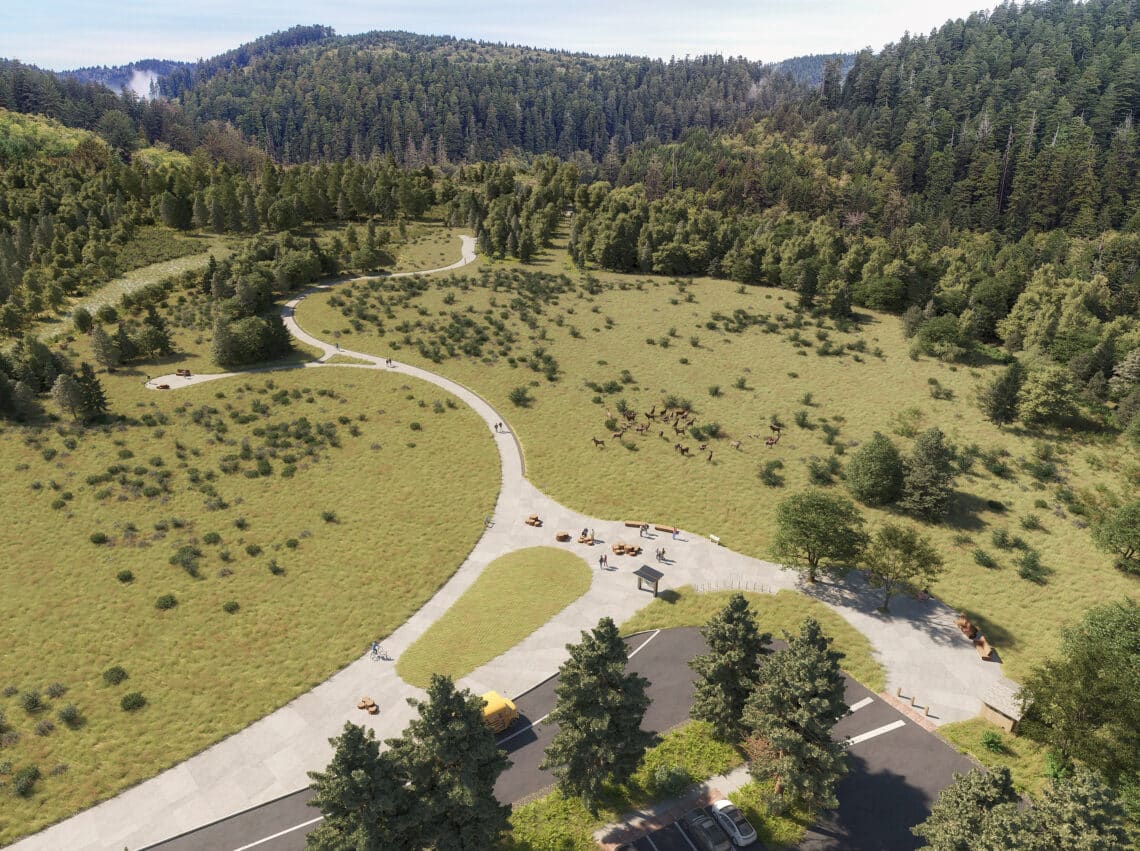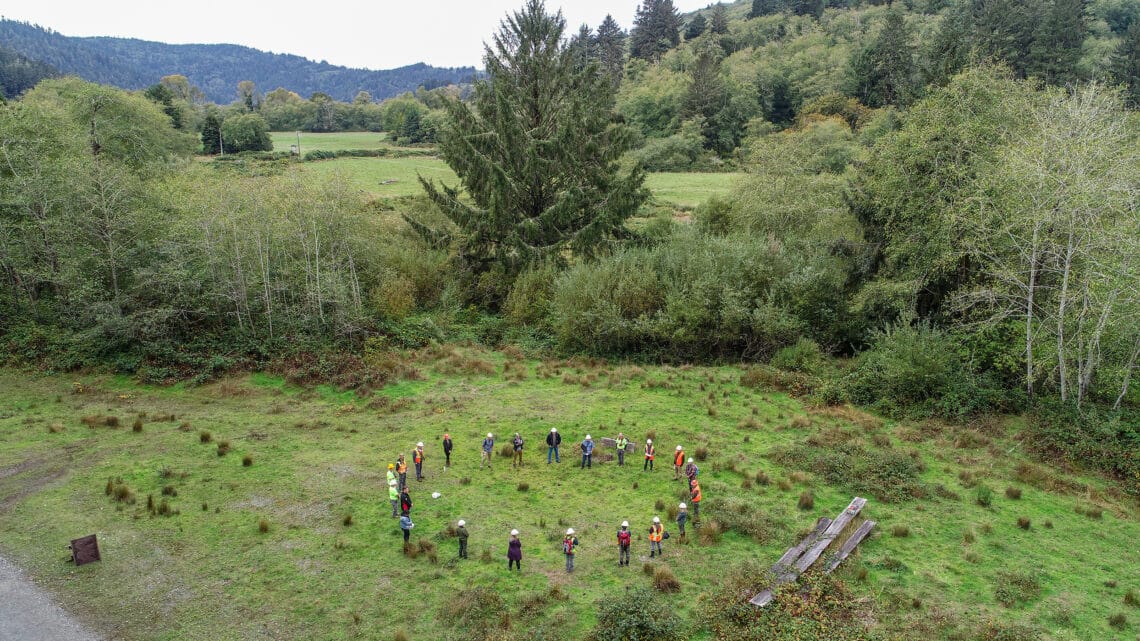Partners take historic first steps toward an Indigenous-owned gateway to Redwood National and State Parks

Some places are keystones, connecting entire landscapes with a significance well beyond their size. Such a site exists just outside Orick, California, along a meandering floodplain surrounded by the ancient redwood groves of Redwood National and State Parks. Here, Prairie Creek and Redwood Creek emerge from the misty forests, their waters intertwining before flowing westward toward the Pacific.
Since time immemorial, Yurok people stewarded this remarkable site, which they call ‘O Rew, arriving each season to fish for the salmon that spawned in the crystalline upstream waters. Across their lands, Yurok people used fallen redwoods as material for houses, sweat lodges, and dugout canoes. Their respect for the ancient trees, which they considered sacred guardians and living beings, continues to this day.
In the mid-1800s, Euro-Americans poured into the region and forcibly removed many Indigenous peoples to expedite the extraction of gold and timber. The massacres and cultural fragmentation that followed mirrored the ecological devastation of the old-growth redwood forest. Logging teams clear-cut the hillsides and hundreds of sawmills made quick work of trees that had survived for more than 2,000 years. Eventually, ‘O Rew became the Orick Mill Site. The land was paved with asphalt, and the riffling waters of Prairie Creek were soon buried in sediment and cut off from the surrounding floodplain.
Early efforts by Save the Redwoods League, like-minded conservation groups, and determined community leaders were instrumental in halting the unchecked decimation of the ancient forest and helping to create the California State Parks system in 1927. Redwood National Park was established in 1968, and in 1994 was combined with three existing state parks to form the jointly managed Redwood National and State Parks. Named a UNESCO World Heritage Site, the park complex contains a staggering 45% percent of the protected old-growth coast redwoods remaining on the planet.
Incredibly, the Orick sawmill remained right next door, turning massive redwoods into lumber while visitors from around the world marveled at the nearby ancient groves. Even after the mill closed in 2009, its legacy of ecological damage remained, compounded by cattle grazing and other uses. And yet, the degraded site held untold potential for healing and renewal.
Restoring habitat and hope at Prairie Creek

In 2013, Save the Redwoods League successfully acquired the 125-acre Orick mill property and began envisioning its future in collaboration with local partners. Having worked to protect Humboldt County’s redwoods for nearly a century, the League appreciated the significance of the site to the surrounding forest, local communities, and park visitors. We saw an exciting opportunity to heal a vital ecosystem and reconnect people to the land.
From the start, the League sought the input, expertise, and partnership of the Yurok Tribe, whose work in watershed restoration includes some of the largest salmon-bearing rivers in the country. California Trout also brought unparalleled leadership in aquatic conservation to the growing project partnership, which included the National Park Service and California State Parks, with critical thought leadership and funding from the California State Coastal Conservancy, National Oceanic and Atmospheric Administration, California Wildlife Conservation Board, and others. Together, we mapped a shared vision for the ecological restoration of Prairie Creek and the creation of a new southern gateway to Redwood National and State Parks, ideally situated along Highway 101, where visitors would be invited to learn and engage across the property. The work would be incredibly complex, meaningful, and worthy of the entire team’s finest efforts.
In 2021, with generous public and private support, the team kicked off a five-year, $23 million restoration of Prairie Creek and its floodplain. The Yurok Tribe Construction Corporation and Yurok Tribe Fisheries Program put their technical expertise and traditional ecological knowledge to work, peeling back decades-old slabs of asphalt and constructing a 2-acre pond to create aquatic habitat. In the second and third years of construction, crews built a new meandering stream channel for a nearly mile-long section of Prairie Creek, which was then reconnected to 18 acres of restored floodplain. More than 50,000 native plants, including coast redwood, black cottonwood, and slough sedge were planted along the Redwood Creek tributary to restore natural habitat, biodiversity, and climate resilience.
Thousands of young coho and Chinook salmon and steelhead trout are now enjoying the pond, restored creek channel, and revived wetlands, as are red-legged frogs, northwestern salamanders, and numerous bird species. Majestic Roosevelt elk and American black bears have also been regularly spotted at the site. With the creek restoration well underway, the League’s focus shifted to the future visitor gateway—and the opportunity to create an innovative model for stewarding this spectacular site.
Reimagining the model for Indigenous guardianship

As the partnership between the Yurok Tribe, the League, and Redwood National and State Parks evolved, so did the vision for long-term stewardship of ‘O Rew. For over a decade, the Yurok Tribe has been a trusted partner in the planning and execution of Prairie Creek’s restoration and has been instrumental in bringing Indigenous perspectives and priorities to designs for the visitor gateway. The Tribe’s commitment to the project and deep bond with this ancestral territory has been invaluable.
Early plans for ‘O Rew called for conveying the 125-acre property to the National Park Service, with the Yurok Tribe as a key partner. But the League and our partners posed a game-changing question: What if we flipped this model? What if the Yurok Tribe assumed full ownership of ‘O Rew, with Redwood National and State Parks taking on a co-stewardship role? It would be an opportunity to create a first-ever model for tribal, federal, and state co-management of nationally significant land, with an Indigenous tribe at the helm.
On March 19, 2024, Save the Redwoods League signed a landmark memorandum of understanding with the Yurok Tribe, National Park Service, and California State Parks, announcing a renewed vision for the ‘O Rew Redwoods Gateway. The agreement describes a shared commitment to Yurok ownership of ‘O Rew, co-management of the site between the Tribe and Redwood National and State Parks, and conservation and public access in perpetuity. This historic first step reflects the League’s broader efforts to conserve and restore the redwood forests of California in partnership with the original Indigenous stewards of these lands.
Rolling up our sleeves for the important work ahead

Within the shared vision for ‘O Rew, the Yurok Tribe would welcome millions of visitors from near and far, creating an unprecedented opportunity to center Indigenous perspectives in the national park experience. The Yurok Tribe intends to construct a cultural and visitor center at ‘O Rew, highlighting their distinct history and living culture, as well as the natural wonders of Redwood National and State Parks. In addition to this state-of-the-art facility, the Tribe plans to build a traditional Yurok village, including plank houses and a sweat house, for cultural activities and interpretation.
Of course, much work remains before this exciting vision of a world-class cultural and recreation gateway can be realized. Prior to the intended conveyance in 2026, the League and its partners plan to complete a $9 million site enhancement, featuring robust visitor amenities, engaging interpretive exhibits, and new, accessible hiking trails. These include a wetland trail, a loop trail, and an extension of the California Coastal Trail, with connections to Lady Bird Johnson Grove, one of the world’s largest remaining stands of old-growth redwoods. Already, $7 million in private and public funding has been identified toward this incredible gateway transformation, with a fundraising goal of $2 million from our supporters.
The project partners must also hammer out the important details of co-management agreements and conservation mechanisms, engage local tribes and communities in planning, and rally significant public funding for ongoing stewardship. But we are thrilled to have come so far and to be announcing this opportunity for a first-ever model for Indigenous guardianship at the doorstep to a globally significant park. As the project moves forward, we are buoyed by the hope that the ‘O Rew Redwoods Gateway will tell the whole world a story of cultural resilience, ecological revitalization, and the ability for committed partners to create lasting positive change.